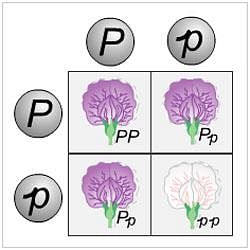Test: Inheritance of One Gene - NEET MCQ
15 Questions MCQ Test Biology Class 12 - Test: Inheritance of One Gene
What process needs to be avoided for carrying of efficient crosses?
What are the possible phenotypes that can be observed after self-crossing violet flowered pea plants that are heterozygous for the flower color gene (Vv)?
Which one of the following cannot be explained on the basis of Mendel's Law of Dominance?
Which of the following was not observed in F2 progeny of true-breeding tall and dwarf plants?
A plant that exhibits two alleles for only one trait is called ________
A cross between tall and dwarf plants was performed, and 120 offspring were produced in which 90 plants were tall and 30 were dwarf. Find out the genotype of their parents.
What should be the phenotype of a cross between violet and white-flowered true-breeding garden pea plants?
The presence of two different alleles at a particular locus results in _________
During meiosis, what happens to the parental alleles?
With green pods as a dominant trait over yellow, which of the following crosses will result in all progeny having yellow pods?
|
78 videos|277 docs|174 tests
|





















